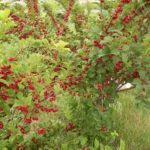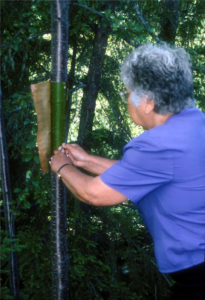 Secwepemc name: pekllánllp (E); bark pekllán (E); fruits: pekllnúse7 (E) –
Secwepemc name: pekllánllp (E); bark pekllán (E); fruits: pekllnúse7 (E) –
The fruits of pin cherry are gathered in early summer and eaten. Pin cherries are bright red and hanging in clusters and Secwepemc people still make them into jams and jellies. They were dried for storage when enough could be gathered. The tough shiny bark can be peeled off the trunk in horizontal strips or sheets, to be used for basket decoration.
 Mary Thomas carefully peels the bark off a pin cherry tree
Mary Thomas carefully peels the bark off a pin cherry tree
![]()
